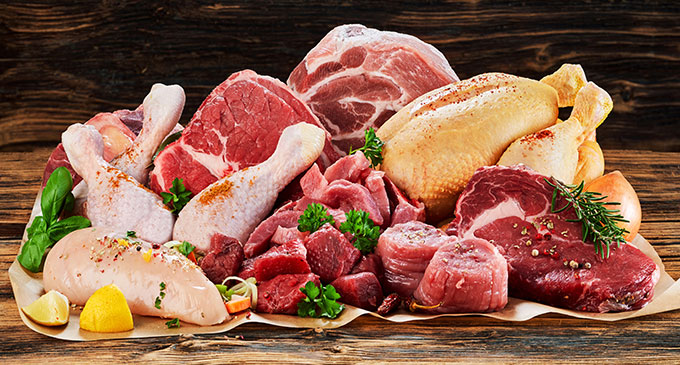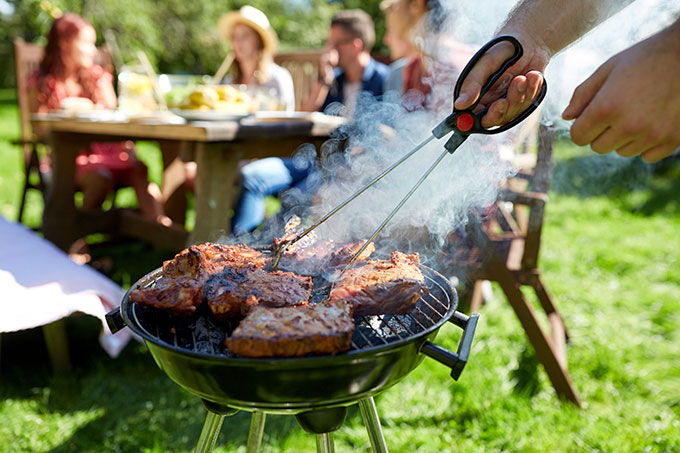
Meat is packed with proteins and is a great source of vitamins essential for maintaining muscle mass, bone health, and iron absorption. Chicken, beef, pork, veal, and other types of animal meat can be prepared, cooked, and eaten in various ways.
And whether you’re a cooking pro or a kitchen novice, you’ll be surprised to find out that there’s more science than magic in cooking meat. This article discusses the different methods in preparing and cooking meat and adds in a few tips on how to make your sliced, cut, and marinated meats more delectable.
Choosing Your Meat Right
The key to having the best meat dish is to get the appropriate cut and the freshest products from your trusted meat shop.
If you’re a beginner, be sure to remember this basic and all too common mantra—look for fresh and prime-cut meat. Before paying for it, inspect the meat closely and check for color, firmness, and odor. Don’t take it if it smells funny or is soggy.
3 Factors That Impact Meat Flavor
The following are important elements in giving the meat its distinct taste:
Presence of fat
A good rule of thumb in choosing pork and beef meat is that, if you want a more flavorful dish, choose one with interspersed fat. This is commonly known as marbling. Visually, it’ll look as if your red met has white or yellowish streaks in it.
You’d want your meat to have some fat on it to ensure that it can retain its taste and juiciness while being cooked.
Softness/ Toughness
Pork meat, poultry, and veal can be cooked and consumed right away, as they’re considered tender meats. Beef, however, ideally needs to be tenderized for one to two weeks to ‘soften’ it. Tenderizing is the process aimed at reducing the toughness of meat fibers, making it more pleasant to the taste. It can be done before selling the meat, or while preparing and cooking it.
Grass-fed vs. Grain-fed
Generally speaking, animals who consume organic products and grass produce tastier meat and are more prone to marbling.
For instance, Spanish hog raisers have special ways to raise Pata Negra pigs, from which the most expensive hams in the world are sourced—feeding them with acorns and corn-fed chicken. The same goes for the mouthwatering Wagyu beef, the priciest beef on the planet which fetches a price of $200 per pound.
To ensure you’re getting the best meat for your dish, check for the following:
- Marbling for better taste
- Firmness in cold meat
- The right cut for your dish
- A fine meat grain
- Minimal connective tissue
- Dark red meat (as it denotes a richer taste)
- Meat should be firm and dry
- Avoid pre-marinated and pre-processed meats as much as possible
If you’re having your meat delivered, just key in “prime meats near me” to have your protein-rich source in a jiffy.
The Different Methods Of Cooking Meats

- Dry Heat: This typically refers to the process of cooking steaks, where the cook turns on the heat to high levels. A dry heat cooking strategy covers a lot of methods which include roasting, grilling, and pan-frying.
- Roasting: Perfect for pork, beef, veal, and lamb meats, this type of cooking involves an oven or an open fire. Large chunks of beef, chicken, pork, and fish can actually be roasted in hot temperatures ranging from 250 degrees to 400 degrees. Ideally, roasted meat should be crispy on the outside yet tender on the inside.
- Broiling: This cooking method entails placing the meat over direct heat while turning it on the other side after one side is cooked. If you’re broiling your meat using an oven, consider moving the rack to the highest level or space that’s closest to the fire or heat source. Try marinating the meat before cooking it or brushing it with sauce and oil intermittently to keep the meat juicy and tender.
Broiling is best for cooking a wide range of meats such as steaks, kebabs, pork and lamb chops, or pork ribs.
- Grilling: Barbecuing, as it’s often called, demands placing the meat of your choice over a grill on top of some charcoal. Experts say that grilling is one of the methods used in broiling.
The best way to do it is to hit the outdoors. If you don’t have an outdoor grill, though, use a stovetop grill instead. Burger patties, chicken, steak, and fish can be cooked by grilling.
- Pan-broiling: This is another means to cook steak, especially organic meat, where the cook places the meat in a skillet. If you have a thinly sliced steak or chop, this is your best bet.
- Pan-frying: The cook places a tiny amount of fat before placing the meat, similar to stir-frying. This cooking method works best for ground and thinly sliced meat.
- Stir-frying: A cooking method that’s similar to pan-frying but in this case, the food is stirred non-stop in high-heat settings. Stir-frying your meat requires the skillet to be really hot. You can use vegetable oil, butter, or bacon grease to sauté your meat in. This cooking method is often the base of many other cooking strategies, especially when making tasty sauces.
- Deep-fat frying: Fried chicken lovers use this cooking method to achieve that crispy on the outside, yet tender on the inside effect. Before deep-fat frying, it’s recommended to have the meat coated with egg and crumbs or batter.
When frying, the meat should be soaked in oil heated at high temperatures. If you want to do it right, have a thermometer so you can measure the temperature and regulate it.
- Baking: Pork, beef, and lamb meats can also be placed inside an oven and baked. Instead of frying pork chops, you can choose this healthier option. Ground meats, casseroles, and meatloaf can also be placed in an oven.
- Moist Heat: Refers to any type of cooking method that uses liquids such as water, stock, or soup. This method is best if you don’t want the meat to become dry after cooking it for a prolonged period.
- Braising or Stewing: This sometimes involves the use of a cooking bag and placing the meat in the oven. Short ribs, lamb shanks, or chicken thighs are some of the more famous dishes that can be cooked through this method. So is pot roast. This way, you don’t have to place water on the meat. Braised meat is best paired with veggies, rice, and pasta.
- Poaching: Not to be confused with the practice of illegal hunting, poaching is a method recommended for cooking fish, poultry, and other tender types of meat under temperatures not exceeding 180 degrees Fahrenheit. As such, this cooking method isn’t known for producing flavorful dishes. That’s because the key to doing it is to never bring the water to a boil, preventing the meat from breaking down and diffusing its flavors. If you want to use chicken strips for sandwiches, stews, and soups, this is how you do it.
As an aside, you can poach an egg too, and here’s a useful tip: add a bit of vinegar to the water to keep the egg white whole.
- Simmering: This method typically entails cooking the meat slowly. Simmering sits in between boiling and poaching; it’s less intense than boiling but at a higher level compared to poaching. Simmering uses higher heat, from 180° F to 205° F, allowing the meat to cook evenly. Simmering demands constant monitoring, though.
This moist heat method of cooking can be done in three ways. Slow simmer is often used in making soup stocks, where there’s little bubbling in the cooking pot. A regular simmering strategy requires medium-low heat and is best for sauces and stews. The third method, called rapid simmer, demands medium to medium-high heat settings and is best for making sauces.
Preparing The Meat
If you’re not planning to cook the meat as soon as you get them, you’ll have to store it in the freezer to keep it fresh. When you’re ready, you can do any of the following:
- Thawing: Once you’re ready to cook the meat, thaw it using a microwave oven. Another option is to remove the meat from the freezer and transfer it to the chiller a few hours before you’re supposed to cook it.
Submerge the meat in cold water. It should be cooked immediately to prevent the formation of bacteria.
- Marinating: This method involves soaking your meat in flavorful liquids, spices, and herbs. This way, your meat becomes more tender and tastier. Avoid leaving the mixture on your meat for more than 12 hours so it won’t become soggy.
- Brining: One of the best ways to keep poultry juicy and tasty is by soaking it in brine. Here’s how to do it:
- Wet brine- Thaw your chicken, duck, or turkey. Mix salt and water. You can add sugar to give it a nice brown color. Bring the mixture to a boil and let it cool. Submerge your poultry meat and cover the pot. Keep it chilled in the refrigerator. When ready to be cooked, just dry the chicken with paper towels.
- Dry Brine- Mix herbs and spices in a bowl. Pat your poultry meat dry. Sprinkle your brine mixture and be careful not to overdo it, as it could get salty. Cover the chicken and refrigerate. Before cooking, rinse off the brine and pat the chicken dry.
How To Cook Meat Based On The Type Of Cut
Beef and pork typically either come in tender and tough cuts. It’s easier to classify these cuts according to how the muscles function. The more active the muscle is, the tougher it gets naturally.
Experts typically use the middle of an animal’s backside to determine the type of cut. The farther down and out the meat is from the middle of the back, the tougher it gets.
This principle remains the same whether the animal meat involved is pork, beef, or lamb.
- Tender cuts: As the term implies, tender meat cuts can be cooked swiftly utilizing the dry method. Tenderloin and striploin are two examples of tender-cut meat.
- Tough cuts: These cuts are best cooked with moist heat, for instance by stewing or braising, to soften them and to add moisture. Tough cuts such as beef shank, blade, and brisket are cooked best through the said methods.
Tips For Cooking Poultry
Like other types of meat, poultry is also versatile and can be cooked in many ways. Whole chicken, duck, or turkey can be roasted or broiled.
Other poultry cuts can be cooked as follows:
- Chicken breasts dry up easily. To avoid this, cook breasts with the skin on to absorb the juices. Otherwise, use the brining method discussed earlier.
- Chicken thighs can be fried, grilled, or roasted. Basically, you can do whatever you want with chicken legs. They’re usually a better buy than chicken breast cuts.
- It’s highly advised to brine turkey so you don’t end up with a dry, tasteless dish.
- The key to knowing if your chicken is completely cooked is to check the temperature. It should be at least 165 degrees.
Tips For Cooking Fish
Like other types of meats, fish can be cooked in a lot of ways. Whole fish can be grilled, fried, or steamed. Depending on the size and kind, others can be cooked by roasting, broiling, or baking.
- Baking fish can cause it to dry up, so it’s best to marinate them beforehand or prepare a dipping sauce.
- Fish fillet can be baked or steamed.
- Remember not to turn the fish meat often to avoid them from becoming mushy. Smaller fillets should be poached as they cook rather easily.
- One of the best ways to cook fatty fishes like salmon, herring, and tuna, is through roasting.
- Broiling can dry up fish meat, too. Don’t forget to brush some oil or sauce to make sure it has a nice tasty glaze when cooked. Don’t overcook your fish to allow the meat to stay tender.
4 Tips For Cooking Different Types Of Meat
Now that you’re more comfortable in preparing mouthwatering meat recipes, take heed of these additional reminders for your cooking success:
- Use a meat thermometer: Baking is not the only cooking method that requires proper temperatures. According to experts, beef and pork meats should have an internal temperature of 145 degrees Fahrenheit. Meanwhile, poultry should have an internal temperature of 165 degrees Fahrenheit before it’s safe for consumption.
- Marinade your meat: Dipping your meat in specially–made spices, herbs, and other natural flavorings result in a more flavorful dish. In some cases, you may need to soak your meat overnight. The longer time the meat spends being soaked in your tasty mixture, the better.
- Don’t pierce your meat: Most people are guilty of stabbing grilled lamb chops with a fork to make sure the heat penetrates and cooks the insides of the meat. Seasoned cooks, however, advise against it, saying your meat will become dry and less flavorful. Pressing your meat also lets out the juices and will have the same undesirable effect.
- Turn up the heat: Too cautious to turn the heat up and burn the meat? Experts say you shouldn’t hesitate to brown the meat as it’s more flavorful that way.
Cooking and preparing meat can be baffling but all you have to do is practice and learn the basics. Follow these tips and you’ll never go wrong!




Leave a Reply